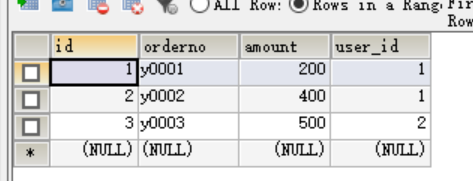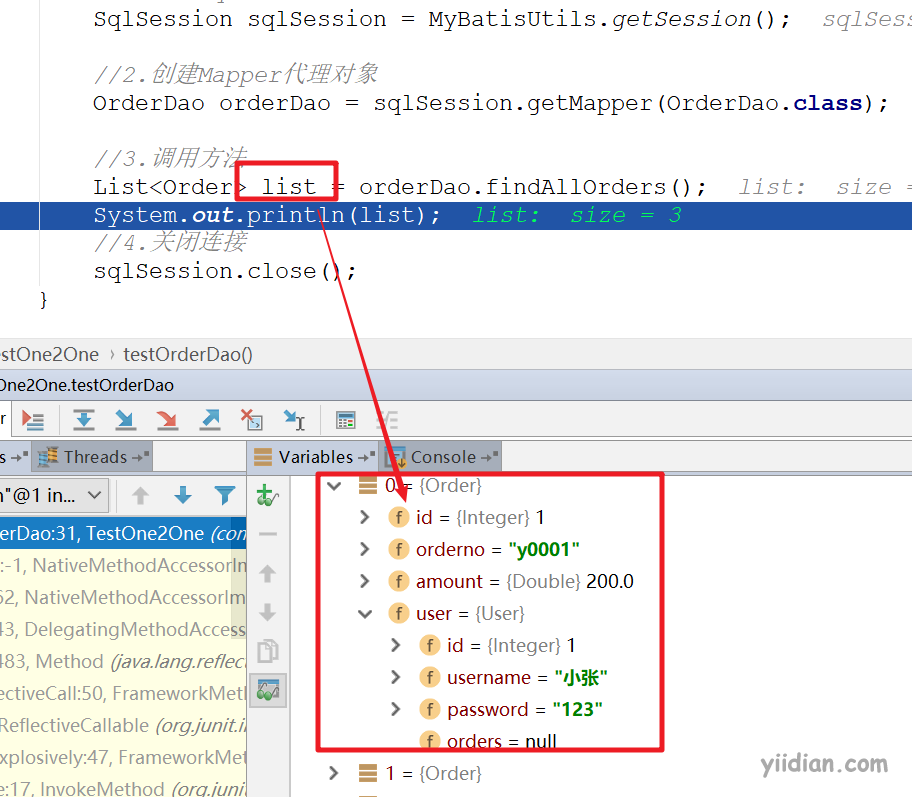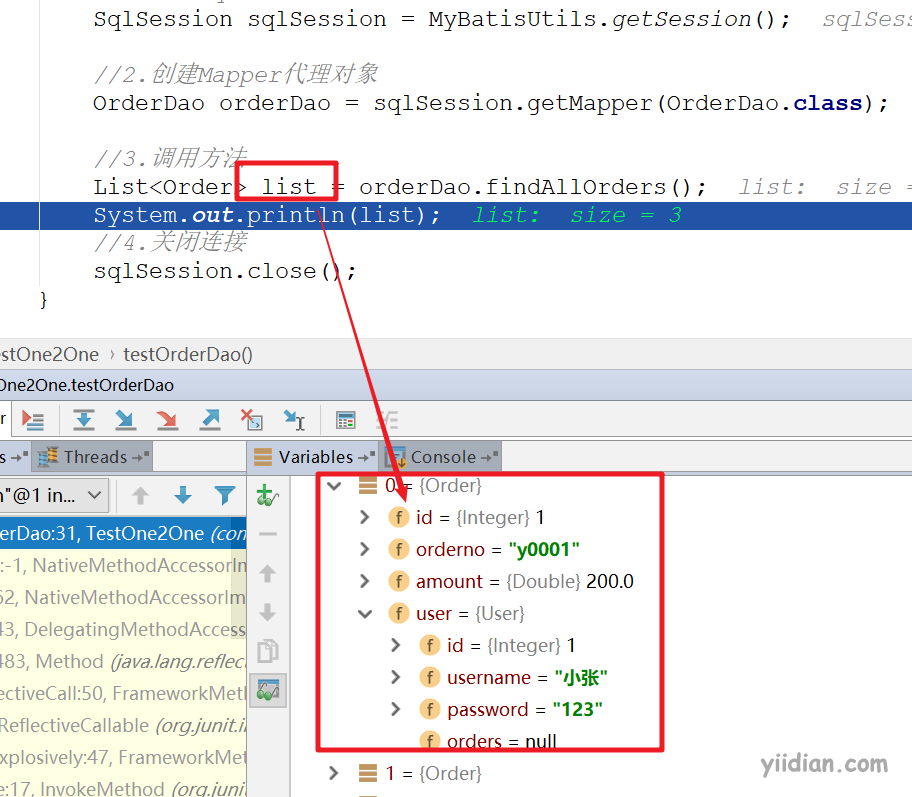Original link: http://www.yiidian.com/mybatis/one-to-one.html
1 What are one-to-one, one-to-many mappings?
Take users and orders for example,
One-to-one: An order belongs to only one user==>The order is one-to-one with the user
One-to-many: A user can have multiple orders==>A user is one-to-many with an order
Note: In MyBatis, if you want to complete a many-to-many relationship, it is actually two one-to-many mappings!
Next, let's explain how MyBatis's one-to-one mapping works.
2 Establish table structure
2.1 Create User Table
CREATE TABLE `t_user` ( `id` int(11) DEFAULT NULL, `username` varchar(50) DEFAULT NULL, `password` varchar(50) DEFAULT NULL ) ENGINE=InnoDB DEFAULT CHARSET=utf8
2.2 Create Order Form
CREATE TABLE `t_order` ( `id` int(11) DEFAULT NULL, `orderno` varchar(100) DEFAULT NULL, `amount` double DEFAULT NULL, `user_id` int(11) DEFAULT NULL ) ENGINE=InnoDB DEFAULT CHARSET=utf8
2.3 Insert Test Data


3 Design Pojo entities and build relationships
3.1 User Entity Class
package com.yiidian.domain;
import java.util.List;
/**
* User Entities
* One Point Tutorial Web - www.yiidian.com
*/
public class User {
private Integer id;
private String username;
public void setOrders(List<Order> orders) {
this.orders = orders;
}
public Integer getId() {
return id;
}
public void setId(Integer id) {
this.id = id;
}
public String getUsername() {
return username;
}
public void setUsername(String username) {
this.username = username;
}
public String getPassword() {
return password;
}
public void setPassword(String password) {
this.password = password;
}
}3.2 Order Entity Class
package com.yiidian.domain;
/**
* Order Entities
* One Point Tutorial Web - www.yiidian.com
*/
public class Order {
private Integer id;
private String orderno;
private Double amount;
private User user;
public Integer getId() {
return id;
}
public void setId(Integer id) {
this.id = id;
}
public String getOrderno() {
return orderno;
}
public void setOrderno(String orderno) {
this.orderno = orderno;
}
public Double getAmount() {
return amount;
}
public void setAmount(Double amount) {
this.amount = amount;
}
public User getUser() {
return user;
}
public void setUser(User user) {
this.user = user;
}
}Order entity class that establishes a relationship with a User entity through the user attribute.Note that here is a User.
4 Write Dao interface
4.1 UserDao interface
package com.yiidian.dao;
import com.yiidian.domain.User;
import java.util.List;
/**
* User Dao Interface
* One Point Tutorial Web - www.yiidian.com
*/
public interface UserDao {
}4.2 OrderDao interface
package com.yiidian.dao;
import com.yiidian.domain.Order;
import com.yiidian.domain.User;
import java.util.List;
/**
* Order Dao Interface
* One Point Tutorial Web - www.yiidian.com
*/
public interface OrderDao {
/**
* Query all orders
*/
public List<Order> findAllOrders();
}5 Write Dao Mapping Configuration
5.1 UserDao.xml Configuration
<?xml version="1.0" encoding="UTF-8"?>
<!DOCTYPE mapper
PUBLIC "-//mybatis.org//DTD Mapper 3.0//EN"
"http://mybatis.org/dtd/mybatis-3-mapper.dtd">
<!--
namespace: Used to specify that the mapping file needs to be mapped Dao Interface
-->
<mapper namespace="com.yiidian.dao.UserDao">
</mapper>5.2 OrderDao.xml Configuration
<?xml version="1.0" encoding="UTF-8"?>
<!DOCTYPE mapper
PUBLIC "-//mybatis.org//DTD Mapper 3.0//EN"
"http://mybatis.org/dtd/mybatis-3-mapper.dtd">
<!--
namespace: Used to specify that the mapping file needs to be mapped Dao Interface
-->
<mapper namespace="com.yiidian.dao.OrderDao">
<!--One-to-one mapping-->
<resultMap id="OrderResultMap" type="com.yiidian.domain.Order">
<id property="id" column="oid"/>
<result property="orderno" column="orderno"/>
<result property="amount" column="amount"/>
<!--Associate the user to which the query order belongs-->
<association property="user" column="id" javaType="com.yiidian.domain.User">
<id property="id" column="id"/>
<result property="username" column="username"/>
<result property="password" column="password"/>
</association>
</resultMap>
<select id="findAllOrders" resultMap="OrderResultMap">
SELECT
o.id oid,
o.orderno orderno,
o.amount amount,
u.*
FROM t_order o
LEFT JOIN t_user u
ON o.user_id = u.id
</select>
</mapper>- Association: used in one-to-one association mapping
- Property: the user property of the corresponding Order class
- column: corresponding foreign key field name
- javaType:Fully qualified name of User class
6 Write test classes
package com.yiidian.mybatis;
import com.yiidian.dao.OrderDao;
import com.yiidian.domain.Order;
import com.yiidian.utils.MyBatisUtils;
import org.apache.ibatis.session.SqlSession;
import org.junit.Test;
import java.util.ArrayList;
import java.util.List;
/**
* MyBatis Test Class-One-to-One Mapping
* One Point Tutorial Web - www.yiidian.com
*/
public class TestOne2One {
/**
* Test one-to-one mapping
*/
@Test
public void testOrderDao(){
//1. Get the SqlSession object
SqlSession sqlSession = MyBatisUtils.getSession();
//2. Create Mapper Proxy Object
OrderDao orderDao = sqlSession.getMapper(OrderDao.class);
//3. Call Method
List<Order> list = orderDao.findAllOrders();
System.out.println(list);
//4. Close the connection
sqlSession.close();
}
}7 Run Test Class
Start the test class in debug mode and look at the list variable to see that the Order object successfully encapsulates the User object's data!


Source download: https://pan.baidu.com/s/1jZrfapjqB_VHI_GLgKPo4g

Welcome to my public number: A little tutorial.Get exclusively organized learning resources and daily dry delivery.
If you are interested in my series of tutorials, you can also follow my website: yiidian.com